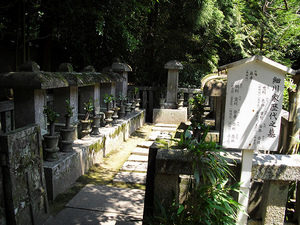Difference between revisions of "Hosokawa clan"
| Line 20: | Line 20: | ||
**[[Hosokawa Tadaoki]] (Sansai, 1563-1646) - son of Fujitaka; second Edo period family head | **[[Hosokawa Tadaoki]] (Sansai, 1563-1646) - son of Fujitaka; second Edo period family head | ||
**[[Hosokawa Gracia]] (1563-1600) - wife of Tadaoki | **[[Hosokawa Gracia]] (1563-1600) - wife of Tadaoki | ||
| + | **[[Hosokawa Okimoto]] - son of Fujitaka | ||
***[[Hosokawa Tadatoshi]] (1586-1641) - son of Tadaoki & Gracia; first Hosokawa lord of Kumamoto, third Edo period family head | ***[[Hosokawa Tadatoshi]] (1586-1641) - son of Tadaoki & Gracia; first Hosokawa lord of Kumamoto, third Edo period family head | ||
| + | ***[[Hosokawa Tachitaka]] - son of Tadaoki | ||
****[[Hosokawa Mitsunao]] (1619-1650) - son of Tadatoshi; second lord of Kumamoto, 4th Edo pd family head | ****[[Hosokawa Mitsunao]] (1619-1650) - son of Tadatoshi; second lord of Kumamoto, 4th Edo pd family head | ||
| + | *****[[Hosokawa Toshishige]] - son of Mitsunao | ||
*****[[Hosokawa Tsunatoshi]] (1643-1714) - son of Mitsunao; third lord of Kumamoto, 5th Edo pd family head | *****[[Hosokawa Tsunatoshi]] (1643-1714) - son of Mitsunao; third lord of Kumamoto, 5th Edo pd family head | ||
******[[Hosokawa Nobunori]] (1676-1732) - son of Tsunatoshi, 6th Edo pd family head | ******[[Hosokawa Nobunori]] (1676-1732) - son of Tsunatoshi, 6th Edo pd family head | ||
Revision as of 08:21, 26 March 2017
- Japanese: 細川家 (Hosokawa-ke)
The Hosokawa were descended from Ashikaga Yoshiyasu (1126-1157), whose great-grandson Ashikaga Yoshisue took the name Hosokawa. Yoshisue's own great-grandson Yoriharu (1299-1352) was a staunch supporter of Ashikaga Takauji during the early Nanbokuchô period. As a result the Hosokawa became influential under the Ashikaga shôguns as a powerful shugo family. Hosokawa Yoriyuki (1329-1392) served as the first kanrei (Deputy/Vice-shôgun) and acted as guardian and counsel to Ashikaga Yoshimitsu. Hosokawa Katsumoto (1430-1473) was one of the most powerful figures in Kyoto politics in his day and shugo of much of Shikoku Island. In part as a result of a succession dispute surrounding Shôgun Ashikaga Yoshimasa, Katsumoto and Yamana Mochitoyo, another powerful shugo, became involved in a conflict that consumed Kyoto and would become known as the Ônin War (1467-77). In the aftermath of this struggle, which is often marked as the opening of the Sengoku Period, the Hosokawa managed to retain their hold on Kyoto into the 16th century. Internal struggles and the rise of the Miyoshi, formerly Hosokawa retainers, led to the eclipse of the Hosokawa by 1550. One branch of the family survived to much success under Hosokawa Fujitaka and his son Tadaoki. Thanks to their efforts, the Hosokawa family would endure as daimyô of Kumamoto han to the end of the Edo Period.
In the Meiji period, the head of the Hosokawa family was named a Marquis (kôshaku) in the new kazoku aristocracy, and held a seat in the House of Peers. The family's private collections, including a wealth of historical documents, artworks, arms & armor, and other artifacts, are today managed as the Eisei Bunko.
Selected Genealogy of the Hosokawa

- Ashikaga Yoshisue
- Ashikaga Yoriharu (1299-1352) - great-grandson of Yoshisue
- Hosokawa Yoriyuki (1329-1392) - son of Yoriharu
- Hosokawa Yorimoto (1343-1397) - son of Yoriharu
- Hosokawa Mitsumoto (1378-1426) - son of Yorimoto
- Hosokawa Mochiyuki (1400-1442) - son of Mitsumoto
- Hosokawa Katsumoto (1430-1473) - son of Mochiyuki
- Hosokawa Mochiyuki (1400-1442) - son of Mitsumoto
- Hosokawa Mitsumoto (1378-1426) - son of Yorimoto
- Ashikaga Yoriharu (1299-1352) - great-grandson of Yoshisue
...
- Hosokawa Fujitaka (Yûsai, 1534-1610) - first Edo period family head
- Hosokawa Tadaoki (Sansai, 1563-1646) - son of Fujitaka; second Edo period family head
- Hosokawa Gracia (1563-1600) - wife of Tadaoki
- Hosokawa Okimoto - son of Fujitaka
- Hosokawa Tadatoshi (1586-1641) - son of Tadaoki & Gracia; first Hosokawa lord of Kumamoto, third Edo period family head
- Hosokawa Tachitaka - son of Tadaoki
- Hosokawa Mitsunao (1619-1650) - son of Tadatoshi; second lord of Kumamoto, 4th Edo pd family head
- Hosokawa Toshishige - son of Mitsunao
- Hosokawa Tsunatoshi (1643-1714) - son of Mitsunao; third lord of Kumamoto, 5th Edo pd family head
- Hosokawa Nobunori (1676-1732) - son of Tsunatoshi, 6th Edo pd family head
- Hosokawa Munetaka (1716-1747) - son of Nobunori, 7th Edo pd family head
- Hosokawa Shigekata (1718-1785) - son of Nobunori, 8th Edo pd family head
- Hosokawa Harutoshi (1758-1787) - son of Shigekata, 9th Edo pd family head
- Hosokawa Narishige (1755-1835) - son of Harutoshi, 10th Edo pd family head
- Hosokawa Naritatsu (1797-1826) - son of Narishige, 11th Edo pd family head
- Hosokawa Tatsuyuki (1784-1818) - son of Narishige
- Hosokawa Narimori (1804-1860) - son of Tatsuyuki; adopted son of Naritatsu; 12th Edo pd family head
- Hosokawa Yoshikuni (Yoshiyuki, 1835-1876) - son of Narimori, 13th Edo pd family head
- Hosokawa Morihisa (1839-1893) - son of Narimori, 14th Edo pd family head, last lord of Kumamoto, Marquis
- Hosokawa Morishige - son of Morihisa, 15th family head, Marquis
- Hosokawa Moritatsu - son of Morihisa, 16th family head, Marquis
- Hosokawa Morisada - son of Moritatsu, 17th family head, Marquis
- Hosokawa Morihiro - son of Morisada, Prime Minister of Japan (1993-1994)
- Hosokawa Morisada - son of Moritatsu, 17th family head, Marquis
- Hosokawa Narimori (1804-1860) - son of Tatsuyuki; adopted son of Naritatsu; 12th Edo pd family head
- Hosokawa Narishige (1755-1835) - son of Harutoshi, 10th Edo pd family head
- Hosokawa Harutoshi (1758-1787) - son of Shigekata, 9th Edo pd family head
- Hosokawa Nobunori (1676-1732) - son of Tsunatoshi, 6th Edo pd family head
- Hosokawa Mitsunao (1619-1650) - son of Tadatoshi; second lord of Kumamoto, 4th Edo pd family head
- Hosokawa Okinori (1723-1785)
- Hosokawa Okinori (1759-1837)
References
- Initial text from Sengoku Biographical Dictionary (Samurai-Archives.com) FWSeal & CEWest, 2005
- Hosokawa-ke ryakkei-zu, Eisei Bunko.
